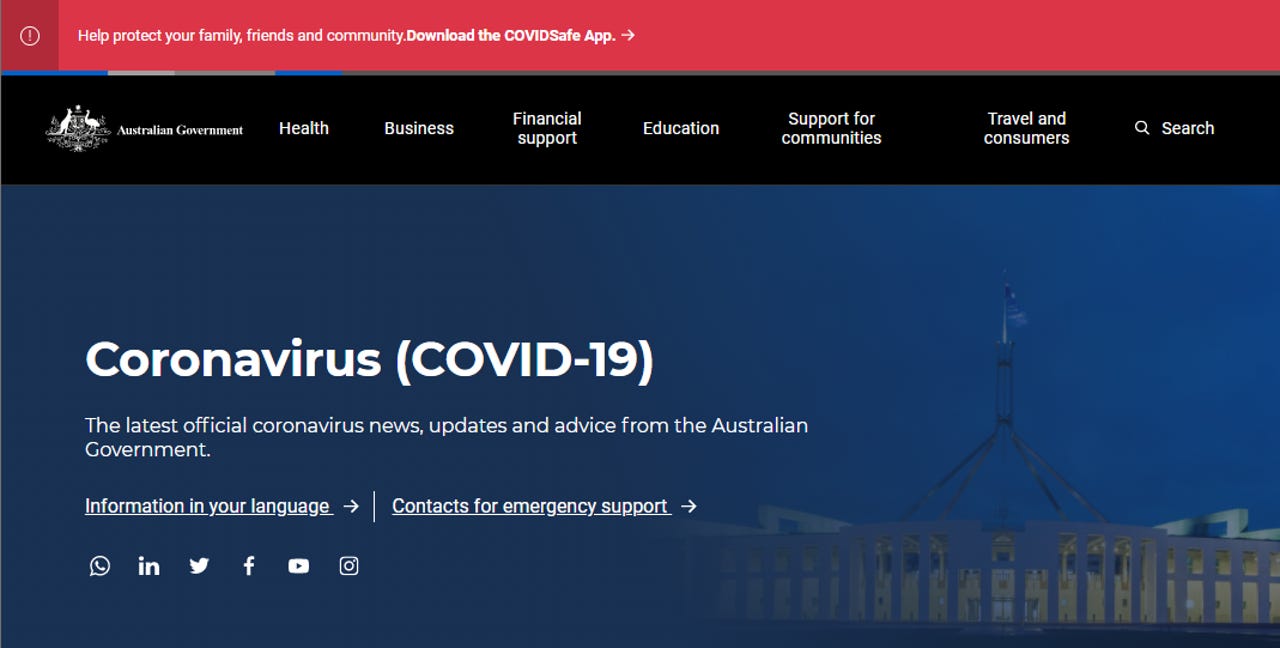A fake DDoS and Centrelink queues spurred Australia.gov.au to appear in six hours

Australia.gov.au
The federal government's COVID-19 hub, Australia.gov.au, was in six hours repurposed to be the one-stop catalogue for information on the virus itself, as well as welfare assistance available to citizens and other coronavirus-related material.
While the time to market was exceptional for a government site, it took a website outage and people queueing amid social distancing measures to force the change.
On Monday 23 March 2020, the federal government's online service portal MyGov crashed when many Australians tried to determine if they qualified for support from the country's Centrelink scheme.
Around the nation, queues around the block at Centrelink offices formed as first-time social security recipients desperately tried to make sense of what was happening by going into shopfronts in person, due to the website failing.
The minister in charge of government services Stuart Robert said the portal suffered a distributed denial of service (DDoS) attack while simultaneously blaming the outage on legitimate traffic that pushed past the 55,000 concurrent users limit set by government.
Those words were barely two hours old when Robert stood up in Parliament to say it was merely 95,000 people trying to connect to myGov that had triggered a DDoS alert, and not an attack at all.
"We've gone from 6,000 to 50,000 to 150,000 all in the space of, a matter of a day. And tonight, they're working to boost it again. I would say to Australians, yes, we are terribly sorry, but at the same time, we are asking Australians, even in these most difficult of circumstances, to be patient. Everyone is doing their best," Prime Minister Scott Morrison later clarified.
Speaking at the Digital Transformation Agency's (DTA) Disruption and Change Digital Summit on Tuesday, DTA digital taskforce lead Lucy Poole said the agency knew it had to very quickly form a response and provide government with a clear, consistent, and easy pathway to communicate with citizens about critical information.
She said multiple departments, including Health, Prime Minister and Cabinet (PM&C), Finance, and Treasury had material they needed to share.
"We very quickly formed a new website, we re-purposed what was Australia.gov.au, we did that in six hours, and of course, in order to do that we had to bring together amazing minds and talent [from across government] and partners, such as Deloitte," Poole said.
Assistant secretary of communications at PM&C Dana Robertson said it took six hours to repurpose a website and "not much longer" to build an entirely new one.
"It was a pretty bracing experience for public servants, Australians in general, to suddenly see -- I think there were pictures coming out of Sydney of people standing in Centrelink queues which is something Australia hasn't seen in a long time, where we had queues of people down the street and I think it was just a stunning realisation that this was way, way bigger than just a health issue," Robertson said.
"It was going to have enormous impacts on people in a whole range of ways and it became very clear quickly that as many of us as possible had to come together.
"I think that spirit of wanting to get something done quickly to serve the Australian people certainly got everyone collaborating well and very fast."
With her department establishing the new National Bushfire Recovery Agency earlier this year and standing up a website for that, Robertson said it was a sort of "dress rehearsal" for the COVID-19 response.
She said a health emergency and an economic emergency at the same time helped focus peoples' minds quite quickly.
"It really brought home who our audience was and who we were talking to and how potentially the audience was a lot of Australians who might not have had a lot of interaction with government, they might never have been a customer of Centrelink, for example, or dealt with the ATO for anything other than their annual tax return," she said.
"The crisis side of it really helped to focus everyone's mind on the user experience and who the audience was and to make sure we thought really clearly about, 'Okay, if I'm a normal person sitting in my house and I need help, what do I want to know?' and that helped us to prioritise that content pretty quickly."
In its annual report published last month, the DTA said there were 29 million visits to Australia.gov.au from March to June this year.
SEE ALSO
- Department of Finance boasts GovCMS withstood COVID-19 traffic spikes
- AU$7.4 billion tied up in active Australian government IT projects
- DTA to refresh Australia's digital transformation strategy
- Consuming government services like Netflix: Minister Robert's pipedream for Australia
- Services Australia's proud achievements include answering the phone
